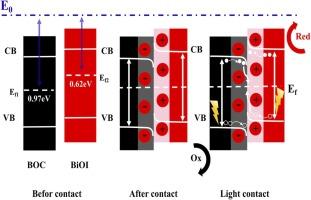构建2D/2D BiOI/Bi2O2CO3 S-scheme异质结促进CO2光还原
IF 6.3
2区 材料科学
Q2 CHEMISTRY, PHYSICAL
引用次数: 0
摘要
采用水热法制备了BiOI/Bi2O2CO3异质结光催化剂,将二氧化碳还原为一氧化碳。所得结果证实了bii /Bi2O2CO3具有s型异质结结构,呈现二维(2D)片层状纳米结构,增强了光诱导载流子的迁移率,抑制了载流子的重组。XPS和EPR数据表明,BOC4异质结中存在丰富的氧空位。这些空位可以有效地降低催化过程中的反应能垒。在bii /Bi2O2CO3 S-scheme异质结中,BOC4表现出优异的光催化CO2还原性能。在模拟光照射下,BiOI/Bi2O2CO3的CO2还原为CO的速率达到8.11 μmol·g⁻¹·h⁻¹,分别是纯BiOI和Bi2O2CO3的3.54倍和2.33倍。认为bii /Bi2O2CO3异质结光催化还原二氧化碳性能的提高是由于异质结与氧空位的协同作用。具有2D/2D形态的BOC4异质结提供了更短的电荷传输路径和更多的界面通道,而氧空位加速了光子产生的载流子的分离,抑制了电子-空穴对的复合。本研究提出了s型异质结和氧空位的协同效应是优化光催化CO2还原的关键因素,为设计氧卤化铋基异质结光催化剂提供了一种新的策略。本文章由计算机程序翻译,如有差异,请以英文原文为准。

Constructing 2D/2D BiOI/Bi2O2CO3 S-scheme heterojunction for boosted CO2 photoreduction
The BiOI/Bi2O2CO3 heterojunction photocatalysts were fabricated through a hydrothermal process for the reduction of carbon dioxide (CO2) to carbon monoxide (CO). The acquired results confirmed that the BiOI/Bi2O2CO3 has an S-scheme heterojunction structure and presents a two-dimensional (2D) lamellar nanostructure, which enhances the mobility of photoinduced carriers and suppresses the recombination of carriers. XPS and EPR data demonstrate the existence of abundant oxygen vacancies in the BOC4 heterojunction. These vacancies can effectively reduce the reaction energy barrier during catalysis. In the BiOI/Bi2O2CO3 S-scheme heterojunctions, the BOC4 shows an excellent photocatalytic CO2 reduction performance. Under simulated light irradiation, the rate of CO2 reduction to CO for the BiOI/Bi2O2CO3 reaches 8.11 μmol·g⁻¹·h⁻¹, which is 3.54- and 2.33-fold greater compared to those of pure BiOI and Bi2O2CO3, respectively. It is considered that the improvement of photocatalytic carbon dioxide reduction performance for the BiOI/Bi2O2CO3 heterojunction is attributed to the synergistic effect of the heterojunction and oxygen vacancies. The BOC4 heterojunction with 2D/2D morphology provides shorter charge transport pathways and more interfacial channels, while the oxygen vacancies accelerate the separation of photon-generated carriers and inhibit electron-hole pair recombination. This work proposes that the synergistic effects of the S-scheme heterojunction and oxygen vacancies are critical factors for optimizing photocatalytic CO2 reduction, offering a novel strategy for designing bismuth oxyhalide-based heterojunction photocatalysts.
求助全文
通过发布文献求助,成功后即可免费获取论文全文。
去求助
来源期刊

Journal of Alloys and Compounds
工程技术-材料科学:综合
CiteScore
11.10
自引率
14.50%
发文量
5146
审稿时长
67 days
期刊介绍:
The Journal of Alloys and Compounds is intended to serve as an international medium for the publication of work on solid materials comprising compounds as well as alloys. Its great strength lies in the diversity of discipline which it encompasses, drawing together results from materials science, solid-state chemistry and physics.
 求助内容:
求助内容: 应助结果提醒方式:
应助结果提醒方式:


